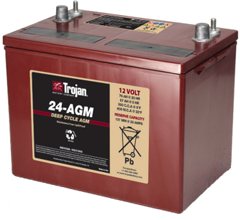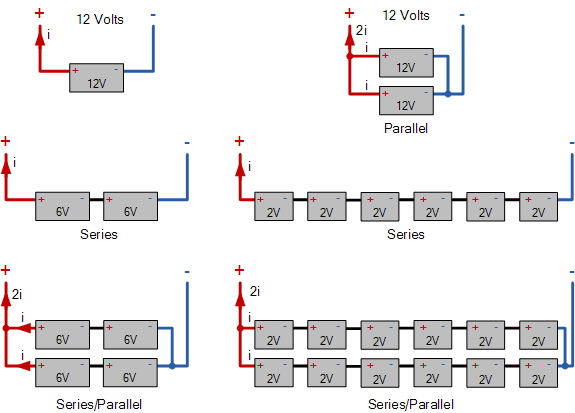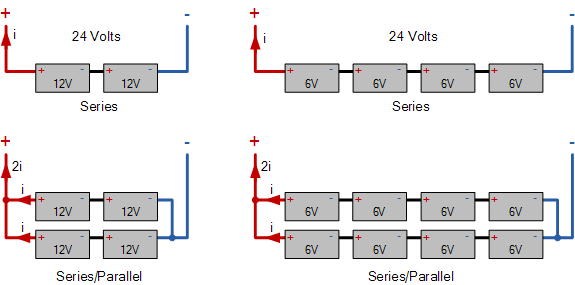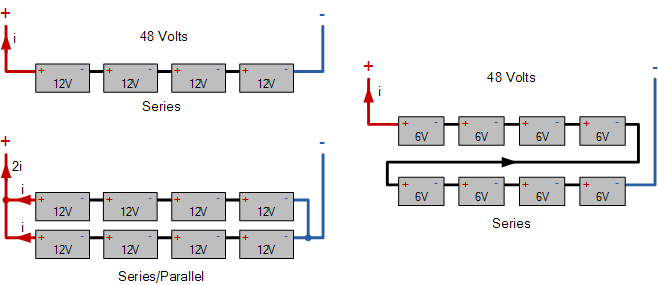Connecting Batteries Together For More Battery Storage
But grid-connected systems with battery backup (Hybrid Systems) are also possible. Battery based grid-connected systems require a different type of inverter and a charge controller to monitor the flow of electricity into and out of the battery bank.
Off-grid or stand alone systems use batteries to store their electrical energy. Off-grid systems are ideal for remote rural areas and applications where the connection to a utility grid is either impractical or unavailable. In these cases, it is more cost effective to install a single stand alone off-grid system than pay the costs of having the local electricity company extend their power lines and cables directly to the home.

A Typical Deep Cycle Battery
All stand-alone and battery backup alternative energy systems whether wind, solar or hydro powered all require some form of battery storage so its important that connecting batteries together is done correctly. An electrical generator charges the batteries, usually during daylight hours for solar and the batteries supply the power when it is needed, often at night and during cloudy weather, so connecting batteries together to store this free solar energy is and important part of any off-grid renewable system.
The two most common types of rechargeable batteries in use today are lead-acid and alkaline. Lead acid batteries have plates made of lead, mixed with other materials and submerged in a sulphuric acid electrolyte solution. The lead acid battery is an integral part of any off-grid alternative energy electrical system and the fundamental lead-acid technology has not changed since its invention.
Lead-acid batteries are the most common in renewable energy charging systems because their initial cost is lower and because they are readily available nearly everywhere in the world. Deep cycle lead acid batteries are called a secondary battery, as it may be recharged by applying current. A primary battery is one that is not rechargeable. All deep cycle batteries are, therefore, secondary batteries.
Deep cycle batteries are a form of lead-acid battery that is specially designed to provide a steady current over a long period of time. There are many different sizes and designs of deep cycle lead-acid batteries available, all designed to be repeatedly discharged by as much as 80% of their capacity so they are a good choice for off-grid systems. Even though they are designed to withstand deep cycling, these batteries will have a longer life if the cycles are shallower.
Connecting Deep Cycle Batteries
Batteries are generally wired or connected together to produce a specific voltage and amp-hour storage capacity. The batteries of small renewable energy systems, for example, those used to power cabins, RV’s and boats, etc, are typically wired to produce 12-volt electricity. Off-grid systems used to power homes and businesses, etc, are typically wired to produce 24 or 48 volt DC electricity. This low-voltage DC electricity can also be converted to mains AC electricity by an inverter which boosts the voltage to 120 volts or 240 volts, commonly used to power larger electrical devices.
When more than one deep cycle battery is connected together the resulting battery bank will have either a different voltage or a different amp-hour capacity (or both) when compared to a single battery. Batteries can be wired or connected together in either series or parallel combinations, or both to increase the voltage or current capacity of the battery bank. Then connecting batteries together allows for more battery storage.
Batteries Connected Together in Series
A battery bank is built up by connecting two or more deep cycle batteries together. Battery banks made from batteries that are connected in series have the same current capacity as the individual batteries, but the voltage is multiplied by the number of batteries in the series string.
In a series connected battery bank the positive terminal of one battery is connected to the negative terminal of the next, and so on. Connecting batteries together in a series combination means a higher voltage for the same current.
Batteries Connected Together in Parallel
Battery banks made from deep cycle batteries that are connected in parallel have the same voltage as the individual batteries, but the current capacity is multiplied by the number of batteries. In a parallel connected battery bank the positive terminal of one battery is connected to the positive terminal of the next with the negative terminal connected to the negative terminal. Connecting batteries together in parallel means a higher current for the same terminal voltage.
Series and parallel combinations of batteries within a battery bank increase both the voltage based on the numbers of batteries in the series strings and the current capacity based on the number of series strings connected in parallel. Connecting batteries together in both series and parallel combinations allows for more battery storage at a higher voltage.
Lets look at some of the ways we can connect batteries together to produce higher voltages and current configurations.
Connecting Batteries Together For 12 Volt Wiring

Connecting Batteries Together For 24 Volt Wiring

Connecting Batteries Together For 48 Volt Wiring

In off-grid stand-alone alternative energy systems, the electrical energy produced by the generating device can not always be used when it is produced. Because the demand for energy does not always coincide with its production, electrical storage batteries are commonly used in many off-grid and grid-tied systems.
The battery bank voltage selection, either 12, 24 or 48 volts often depends on the load voltage requirements of the system, the storage capacity required and the type of batteries available. For larger loads it is sometimes better to connect deep cycle batteries together to produce higher voltages in order to lower the system currents.
For example, a 240 watt DC load operating from a 12 volt battery draws about 20 amps, where as a 240 watt DC load operating from a 48 volt battery only draws 5 amperes, a quarter of the current. This lower system current has many advantages by reducing the size of the cabling, isolation switches and fuses used thereby saving you money.
One final safety point about connecting lead-acid batteries together. Lead acid deep cycle batteries are the most dangerous part of any solar or wind power system. Gloves, eye protection such as goggles and masks as well as old clothes must be worn when handling lead acid batteries and electrolyte as “battery acid” both burns and irritates skin and eyes.
To find out more about “connecting batteries together” and how you can use them as part of a Home Solar system, or to explore the advantages and disadvantages of connecting batteries together for more battery storage and how you can use Deep Cycle Batteries as an alternative to automotive batteries, then Click Here and get your copy of one of the top battery builders guide from Amazon today and learn how to build, rebuild and recondition deep cycle lead-acid batteries
http://www.alternative-energy-tutorials.com/energy-articles/connecting-batteries-together.html


ليست هناك تعليقات:
إرسال تعليق